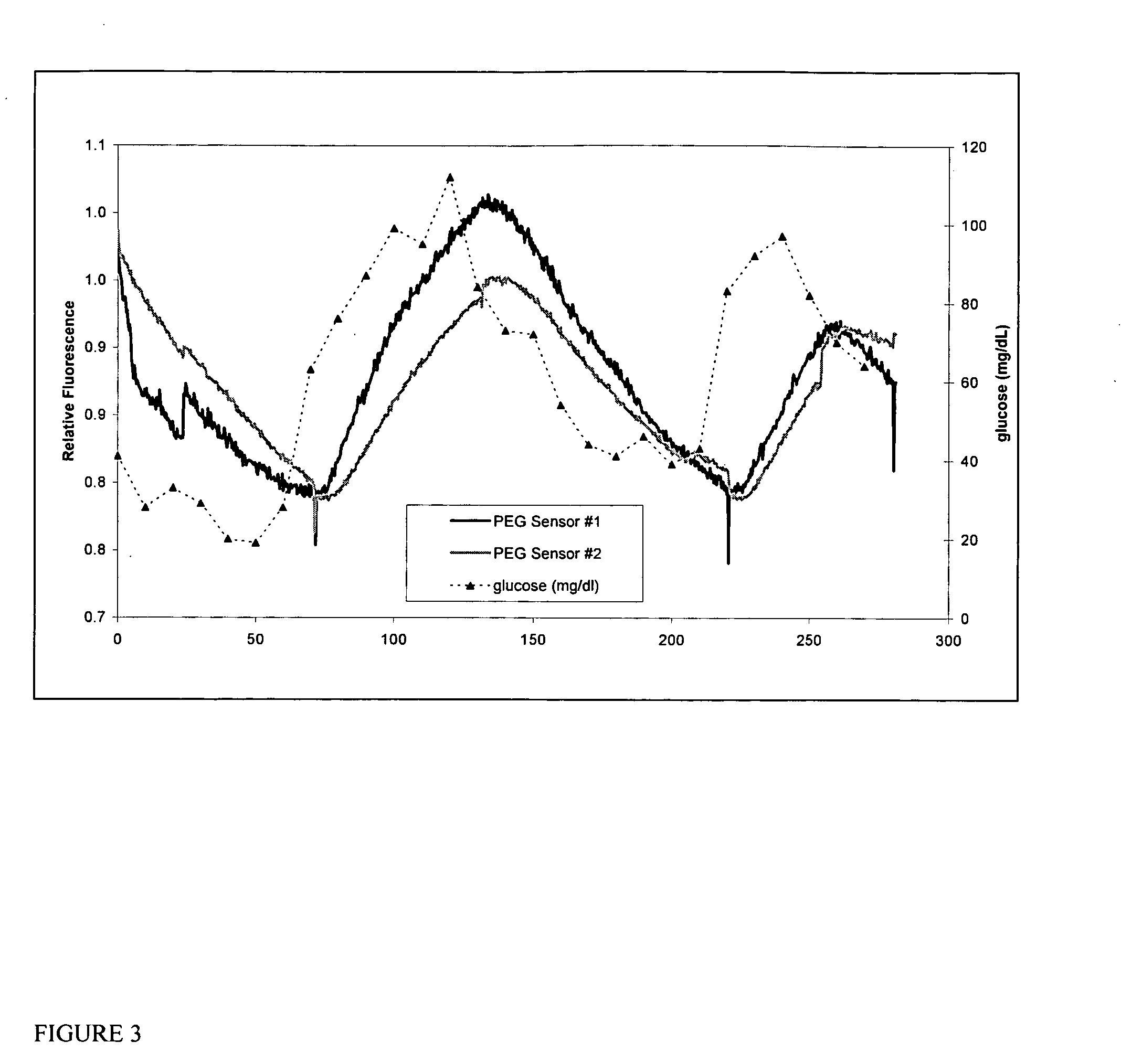Multianalyte sensor
a sensor and multi-analyte technology, applied in the field of multi-analyte sensors, can solve the problems of inconvenient use, pain, inconvenience, and non-compliance, and complicate the development and performance analysis of sensors
- Summary
- Abstract
- Description
- Claims
- Application Information
AI Technical Summary
Benefits of technology
Problems solved by technology
Method used
Image
Examples
example 1
Hydrogel Glucose Biosensor on an Optical Fiber
[0068] This example illustrates the use of a hydrogel with binding protein coated on an optical fiber as a device for continuous monitoring glucose concentration in vitro and in vivo. A solution of 25.7 mg of 8-arm PEG-NH2 in 0.3 mL PBS buffer (pH 7.4) in a 1.5 mL Eppendorf vial was mixed with 200 uL of NBD-labeled E149C / A231R / L238S GGBP in PBS buffer (protein concentration is 125.5 uM with dye / protein ratio 0.9). The NBD-labeled E149C / A231R / L238S GGBP was prepared as described in U.S. application Ser. No. 10 / 040,077, filed Jan. 4, 2002, which is incorporated herein by reference. Next, 24.5 mg of BTC-PEG-BTC in 0.5 mL PBS buffer was added to the mixture. After thorough mixing, the final mixture was manually coated onto the end of a 470 um optical fiber (Ceram Optec, East Longmeadow, Mass.), and the reaction was allowed to continue for at least two hours. The gel formed within a few minutes and formed very thin hydrogel films with a thic...
example 2
Fatty Acid Binding Protein Immobilized in a PEG Hydrogel
[0071] This example describes making hydrogel biosensors for fatty acid detection. A solution of 200 ug of ADIFAB (AcryloDated Intestinal Fatty Acid Binding Protein with dye / protein ratio approximately 1.0, Molecular Probes) in 1.0 mL of buffer (50 mM Tris, 1 mM EDTA, 0.05% azide, pH 8.0) was prepared. The binding protein solution (210 uL) was combined with 21 mg of 8-arm PEG-NH2 (10,000 MW, Nektar) in a 1.5 mL Eppendorf vial. The mixture of 8-arm PEG-NH2 and binding protein was further mixed with 18 mg of BTC-PEG-BTC (3,400 MW, Nektar) in 180 uL PBS buffer (pH 7.4) and vortexed. The mixture was immediately injected between two glass plates separated by a 2 mm spacer. After the reaction was complete, the formed hydrogel sheet was punched into 5 mm diameter disks, which were then soaked in PBS buffer for two days to wash away unbound protein and monomer residuals. The binding of fatty acid to the hydrogel disks was measured usi...
example 3
Multianalyte Hydrogel Biosensor on an Opticalfiber for Detection of Glucose and Lactate
[0072] This example illustrates the use of a hydrogel with two binding proteins coated on an optical fiber as a device for simultaneous monitoring of glucose and L-lactate. An NBD-labeled GGBP derivative is used to monitor glucose and an acrylodan-labeled GGBP derivative with mutations for selective lactate binding is used to monitor L-lactate. A solution of 25.7 mg of 8-arm PEG-NH2 in 0.3 mL PBS buffer (pH 7.4) in a 1.5 mL Eppendorf vial is mixed with a 200 uL 1:1 equimolar mixture (approximately 50-65 uM each) of (1) NBD-labeled glucose-specific GGBP mutant E149C / A231R / L238S, and (2) Acrylodan-labeled lactate-specific GGBP mutant Y10K / D14K / N91K / K92L / E149C / H152M / D154H / R158K / W183K / D236A / N256D in PBS buffer. Next, 24.5 mg of BTC-PEG-BTC in 0.5 mL PBS buffer is added to the mixture. After thorough mixing, the final mixture is manually coated onto the end of a 470 um optical fiber (Ceram Optec, East...
PUM
| Property | Measurement | Unit |
|---|---|---|
| Concentration | aaaaa | aaaaa |
Abstract
Description
Claims
Application Information
 Login to View More
Login to View More - R&D
- Intellectual Property
- Life Sciences
- Materials
- Tech Scout
- Unparalleled Data Quality
- Higher Quality Content
- 60% Fewer Hallucinations
Browse by: Latest US Patents, China's latest patents, Technical Efficacy Thesaurus, Application Domain, Technology Topic, Popular Technical Reports.
© 2025 PatSnap. All rights reserved.Legal|Privacy policy|Modern Slavery Act Transparency Statement|Sitemap|About US| Contact US: help@patsnap.com



